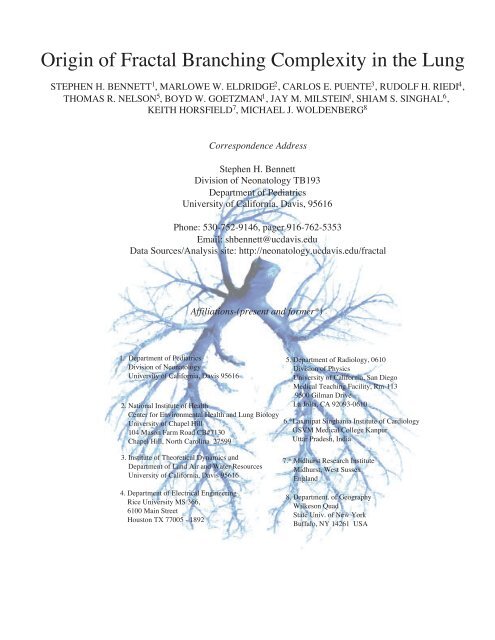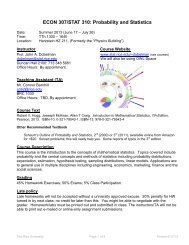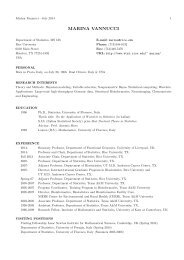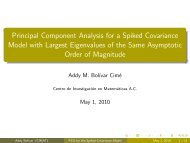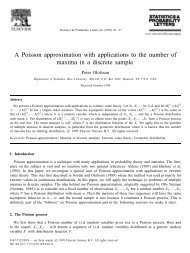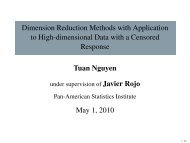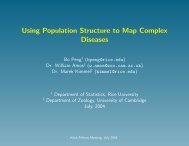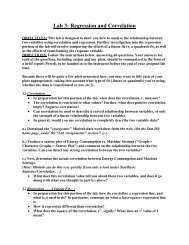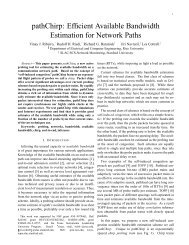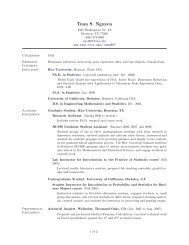Origin of Fractal Branching Complexity in the Lung - Department of ...
Origin of Fractal Branching Complexity in the Lung - Department of ...
Origin of Fractal Branching Complexity in the Lung - Department of ...
You also want an ePaper? Increase the reach of your titles
YUMPU automatically turns print PDFs into web optimized ePapers that Google loves.
<strong>Orig<strong>in</strong></strong> <strong>of</strong> <strong>Fractal</strong> <strong>Branch<strong>in</strong>g</strong> <strong>Complexity</strong> <strong>in</strong> <strong>the</strong> <strong>Lung</strong><br />
STEPHEN H. BENNETT 1 , MARLOWE W. ELDRIDGE 2 , CARLOS E. PUENTE 3 , RUDOLF H. RIEDI 4 ,<br />
THOMAS R. NELSON 5 , BOYD W. GOETZMAN 1 , JAY M. MILSTEIN 1 , SHIAM S. SINGHAL 6 ,<br />
KEITH HORSFIELD 7 , MICHAEL J. WOLDENBERG 8<br />
Correspondence Address<br />
Stephen H. Bennett<br />
Division <strong>of</strong> Neonatology TB193<br />
<strong>Department</strong> <strong>of</strong> Pediatrics<br />
University <strong>of</strong> California, Davis, 95616<br />
Phone: 530-752-9146, pager 916-762-5353<br />
Email: shbennett@ucdavis.edu<br />
Data Sources/Analysis site: http://neonatology.ucdavis.edu/fractal<br />
1. <strong>Department</strong> <strong>of</strong> Pediatrics<br />
Division <strong>of</strong> Neonatology<br />
University <strong>of</strong> California, Davis 95616<br />
2. National Institute <strong>of</strong> Health<br />
Center for Environmental Health and <strong>Lung</strong> Biology<br />
University <strong>of</strong> Chapel Hill<br />
104 Mason Farm Road CB#7130<br />
Chapel Hill, North Carol<strong>in</strong>a 27599<br />
3. Institute <strong>of</strong> Theoretical Dynamics and<br />
<strong>Department</strong> <strong>of</strong> Land Air and Water Resources<br />
University <strong>of</strong> California, Davis 95616<br />
4. <strong>Department</strong> <strong>of</strong> Electrical Eng<strong>in</strong>eer<strong>in</strong>g<br />
Rice University MS 366,<br />
6100 Ma<strong>in</strong> Street<br />
Houston TX 77005 - 1892<br />
Affiliations-(present and former*)<br />
5. <strong>Department</strong> <strong>of</strong> Radiology, 0610<br />
Division <strong>of</strong> Physics<br />
University <strong>of</strong> California, San Diego<br />
Medical Teach<strong>in</strong>g Facility, Rm-113<br />
9500 Gilman Drive<br />
La Jolla, CA 92093-0610<br />
6.*Laxmipat S<strong>in</strong>ghania Institute <strong>of</strong> Cardiology<br />
GSVM Medical College Kanpur<br />
Uttar Pradesh, India<br />
7.* Midhurst Research Institute<br />
Midhurst, West Sussex<br />
England<br />
8. <strong>Department</strong>. <strong>of</strong> Geography<br />
Wilkeson Quad<br />
State Univ. <strong>of</strong> New York<br />
Buffalo, NY 14261 USA
<strong>Orig<strong>in</strong></strong> <strong>of</strong> <strong>Fractal</strong> <strong>Branch<strong>in</strong>g</strong> <strong>Complexity</strong> <strong>in</strong> <strong>the</strong> <strong>Lung</strong><br />
STEPHEN H. BENNETT, MARLOWE W. ELDRIDGE, CARLOS E. PUENTE, RUDOLF H. RIEDI,<br />
THOMAS R. NELSON, BOYD W. GOETZMAN, JAY M. MILSTEIN,<br />
SHIAM S. SINGHAL, KEITH HORSFIELD, MICHAEL J. WOLDENBERG<br />
<strong>Fractal</strong> and non-fractal <strong>the</strong>ories predict universal designs for biological branch<strong>in</strong>g transport networks whereby energy<br />
dissipation is m<strong>in</strong>imized. However, <strong>the</strong>y are <strong>in</strong>adequate to account for adaptation via designs that appear sub-<br />
optimal. Therefore we have evaluated ano<strong>the</strong>r <strong>the</strong>ory <strong>in</strong> <strong>the</strong> develop<strong>in</strong>g lung which is based on bifurcation design and<br />
<strong>the</strong> pr<strong>in</strong>ciple <strong>of</strong> self-organized criticality. The latter is a universal physical <strong>the</strong>ory whereby fractal and multifractal<br />
patterns <strong>of</strong> branch<strong>in</strong>g complexity self-organize <strong>in</strong>to meta-stable states poised between order and disorder. We f<strong>in</strong>d<br />
bifurcation design <strong>in</strong> <strong>the</strong> lung manifests an adaptable fractal dimension, with spatial scal<strong>in</strong>g properties implicat<strong>in</strong>g<br />
structural orig<strong>in</strong>s <strong>of</strong> airway and vascular disease susceptibility.<br />
INTRODUCTION<br />
<strong>Branch<strong>in</strong>g</strong> transport networks <strong>in</strong> biology form patterns adher<strong>in</strong>g to design pr<strong>in</strong>ciples that<br />
are energetically favorable, a condition considered important for species survival(1). Such<br />
networks are constructed <strong>of</strong> vessels via a bifurcat<strong>in</strong>g structure, where <strong>the</strong> parent and daughter<br />
vessels, <strong>of</strong> diameters d0, d1, and d2, respectively, satisfy a bifurcation design relationship<br />
x x x<br />
d = d + d exhibit<strong>in</strong>g <strong>the</strong> property <strong>of</strong> self-organization (2). The bifurcation exponent, x, is said<br />
0 1 2<br />
to specify a design because its value reflects <strong>the</strong> fluid dynamic efficiency and energy dissipation<br />
dur<strong>in</strong>g transport(3). At <strong>the</strong> network level, an <strong>in</strong>dex <strong>of</strong> design, X, reflects a power-law relationship<br />
between vessel number and diameter N d X<br />
∝ − , where x ≈ X(4).<br />
Although it is not clear to what<br />
extent branch<strong>in</strong>g complexity implicit <strong>in</strong> a power law contributes to form and function beyond <strong>the</strong><br />
vessel level (4-6), both fractal and non-fractal <strong>the</strong>ories <strong>of</strong> biological network organization predict<br />
universal designs with energy dissipation properties at a global m<strong>in</strong>imum or a relative m<strong>in</strong>imum<br />
(1,2,7). Not accounted for are biological exceptions, such as <strong>the</strong> fetal and neonatal pulmonary<br />
arterial circulation where design at birth beg<strong>in</strong>s with an unusually unstable form <strong>of</strong> organization<br />
for fluid transport(8). A premise <strong>of</strong> universal <strong>the</strong>ories is that <strong>the</strong> end design is static, be<strong>in</strong>g<br />
<strong>in</strong>dependent <strong>of</strong> <strong>in</strong>fluences from <strong>the</strong> environment and unaffected by <strong>the</strong> functional requirements<br />
dur<strong>in</strong>g development. However, not fully anticipated <strong>in</strong> current <strong>the</strong>ory, is that <strong>the</strong> embryonic form<br />
<strong>of</strong> design may metamorphose <strong>in</strong>to a f<strong>in</strong>al form dur<strong>in</strong>g growth and development, <strong>in</strong> which <strong>the</strong> early<br />
form may satisfy quite different criteria than <strong>the</strong> f<strong>in</strong>al, juvenile or adult state(9) and where<br />
patterns and tim<strong>in</strong>g <strong>of</strong> adaptation dur<strong>in</strong>g successive developmental stages may be just as<br />
important for species survival, as <strong>the</strong> f<strong>in</strong>al design(10). In this regard, present <strong>the</strong>ories <strong>of</strong> biological<br />
1
design are limited <strong>in</strong> extent because <strong>the</strong>y do no <strong>of</strong>fer explanations for adaptation or mal-<br />
adaptation via transitional forms <strong>of</strong> organization, only <strong>the</strong> achievement <strong>of</strong> an idealized f<strong>in</strong>al<br />
teleological design(1,2,7,9).<br />
In his tome On Growth and Form, D’Arcy Wentworth Thompson envisioned a universal<br />
pr<strong>in</strong>ciple govern<strong>in</strong>g <strong>the</strong> development and adaptation <strong>of</strong> form (9) that may have a foundation <strong>in</strong> a<br />
recently proposed physical <strong>the</strong>ory called self-organized criticality(11). This <strong>the</strong>ory postulates a<br />
universal process <strong>of</strong> fractal pattern formation for self-organiz<strong>in</strong>g fluid transport networks <strong>in</strong><br />
nature predict<strong>in</strong>g adaptable patterns <strong>of</strong> complexity not accounted for <strong>in</strong> present fractal and non-<br />
fractal <strong>the</strong>ories <strong>of</strong> biological network design(12-13). For example, present fractal <strong>the</strong>ory <strong>of</strong><br />
biological branch<strong>in</strong>g form is based upon <strong>the</strong> pr<strong>in</strong>ciple <strong>of</strong> self-similarity where <strong>the</strong> condition <strong>of</strong><br />
x=X, results <strong>in</strong> a space-fill<strong>in</strong>g fractal structure, such that x=X=D is predicted to be fixed,<br />
emerg<strong>in</strong>g early <strong>in</strong> development(7). However, biological systems do not necessarily exhibit a<br />
s<strong>in</strong>gular power-law with a design that is universal (4), nor are power-laws <strong>of</strong> biological branch<strong>in</strong>g<br />
networks scale-<strong>in</strong>variant, a condition necessary for self-similarity(14). At present, <strong>the</strong> fractal<br />
architecture <strong>of</strong> biological networks is an unresolved controversial conjecture, mak<strong>in</strong>g it unclear as<br />
to whe<strong>the</strong>r any form <strong>of</strong> fractal dimension characterizes biological network design(15, 16).<br />
Alternatively, a non-fractal <strong>the</strong>ory predicts that biological networks are unorganized stochastic<br />
network <strong>of</strong> bifurcations whose overall function is unaffected by network scal<strong>in</strong>g, be<strong>in</strong>g<br />
determ<strong>in</strong>ed by geometric properties resid<strong>in</strong>g at <strong>the</strong> vessel level only(1, 2). Design universality is<br />
characterized by a prevail<strong>in</strong>g network average <strong>of</strong> x co<strong>in</strong>cid<strong>in</strong>g with a global m<strong>in</strong>imum or relative<br />
m<strong>in</strong>imum <strong>of</strong> energy dissipation(3). However, one universal feature <strong>of</strong> biological networks not<br />
accounted for a universal <strong>the</strong>ory is <strong>the</strong> manifestation <strong>of</strong> a broad non-normal distribution <strong>of</strong><br />
bifurcation designs for which a simple average does not necessarily characterize <strong>the</strong> population<br />
uniquely (4,5,8). As large proportions about <strong>the</strong> average deviate from ideal pr<strong>in</strong>ciples it is not<br />
known if <strong>the</strong> phenomenon is simply biological variation or is related to <strong>the</strong> optimization <strong>of</strong> some<br />
alternative global cost function related to bifurcation design (3). Alternatively, aberrations not<br />
accounted for by universal <strong>the</strong>ories are predicted to be dynamic elements <strong>of</strong> complexity <strong>in</strong> a self-<br />
organized critical state(12, 17-19), In attempt<strong>in</strong>g to build upon Thompson’s vision, more vital is<br />
<strong>the</strong> notion that self-organized criticality does not end with an ideal teleological design, but beg<strong>in</strong>s<br />
with a universal process underp<strong>in</strong>n<strong>in</strong>g design formation, development and adaptation that would<br />
lead to possible explanations <strong>of</strong> diversity and uniformity <strong>in</strong> biological form.<br />
2
The case for a fractal self-organized criticality model <strong>in</strong> biological transport networks is<br />
compell<strong>in</strong>g. First, fractal forms <strong>of</strong> branch<strong>in</strong>g are widespread <strong>in</strong> nature and are advantageous for<br />
transport because such forms optimize energy dissipation relative to o<strong>the</strong>r patterns(13). Second,<br />
self-organized criticality(11-12) represents a plausible <strong>the</strong>ory <strong>of</strong> fractal pattern formation <strong>of</strong><br />
import <strong>in</strong> expla<strong>in</strong><strong>in</strong>g <strong>the</strong> process <strong>of</strong> biological network adaptation(9). Ra<strong>the</strong>r than an a priori<br />
assumption regard<strong>in</strong>g universal fractal design, a self-organized critical state postulates a universal<br />
organizational configuration <strong>of</strong> fractal branch<strong>in</strong>g complexity resid<strong>in</strong>g <strong>in</strong> a marg<strong>in</strong>ally stable state,<br />
possibly far removed from a global m<strong>in</strong>imum <strong>of</strong> energy dissipation(12). This <strong>the</strong>ory <strong>in</strong>corporates<br />
additional patterns <strong>of</strong> branch<strong>in</strong>g complexity, such as multifractal branch<strong>in</strong>g (13) and self-aff<strong>in</strong>e<br />
fractal scal<strong>in</strong>g(12,14) where <strong>the</strong> effect <strong>of</strong> complexity is to break symmetry and impart network<br />
scal<strong>in</strong>g properties that spatially modulate forces <strong>in</strong> self-organization (13). For complexity to<br />
emerge, criticality requires <strong>the</strong> presence <strong>of</strong> a coupled feedback process to ensure a steady state for<br />
which a system is marg<strong>in</strong>ally stable aga<strong>in</strong>st a disturbance (12). Universal patterns are postulated<br />
to develop when two types <strong>of</strong> feedback processes are coupled, one threshold-dependent, <strong>the</strong> o<strong>the</strong>r<br />
threshold-<strong>in</strong>dependent, (17-19). The coupled process is general so that different transport systems,<br />
biological or non-liv<strong>in</strong>g, can form universal patterns <strong>of</strong> complexity by different mechanisms(20).<br />
Consequently, where non-liv<strong>in</strong>g transport systems develop over eons <strong>of</strong> time via a punctuated<br />
distribution <strong>of</strong> forces(13), biological pattern development depends upon <strong>the</strong> critical tim<strong>in</strong>g <strong>of</strong><br />
<strong>in</strong>formation expression, constra<strong>in</strong>ed forces and <strong>in</strong>direct environmental circumstances (21). Hence,<br />
for biological networks, self-organized criticality conceives design as a complex adaptive process<br />
conta<strong>in</strong><strong>in</strong>g a cont<strong>in</strong>uum <strong>of</strong> physical transitional states with universal patterns <strong>of</strong> complexity<br />
appear<strong>in</strong>g at all stages <strong>of</strong> development(22). Consequently, this <strong>the</strong>ory would be expected to<br />
exhibit locally emergent fractal scal<strong>in</strong>g behavior, giv<strong>in</strong>g <strong>in</strong>sight <strong>in</strong>to a network organizational<br />
process modulat<strong>in</strong>g physiological adaptation and mal-adaptation, ra<strong>the</strong>r than a universal fractal<br />
dimension.<br />
The mammalian lung is an example <strong>of</strong> a self-organiz<strong>in</strong>g biological branch<strong>in</strong>g transport<br />
network where conclusive evidence discrim<strong>in</strong>at<strong>in</strong>g between a simple-fractal, a complex-fractal or<br />
a non-fractal <strong>the</strong>ory is lack<strong>in</strong>g. We will formalize fractal branch<strong>in</strong>g complexity, generaliz<strong>in</strong>g self-<br />
similar and self-aff<strong>in</strong>e scal<strong>in</strong>g <strong>in</strong> power-law behavior, along with patterns <strong>of</strong> branch<strong>in</strong>g for fractal<br />
and non-fractal design <strong>in</strong> biological trees, us<strong>in</strong>g a dimension def<strong>in</strong>ed accord<strong>in</strong>g to bifurcation<br />
design, x. From this formulation, alternative <strong>the</strong>ories <strong>of</strong> biological network organization will be<br />
3
tested <strong>in</strong> <strong>the</strong> transport vessels <strong>of</strong> <strong>the</strong> lung pulmonary arteries and airways, evaluated by assess<strong>in</strong>g<br />
<strong>the</strong> multifractal spectrum <strong>in</strong>herent <strong>in</strong> <strong>the</strong> power-law behavior, where<strong>in</strong> <strong>the</strong> spectra <strong>of</strong> non-fractal,<br />
mononfractal and multifractal branch<strong>in</strong>g processes can be assessed(23).<br />
PATTERNS OF COMPLEXITY IN A SELF-ORGANIZED CRITICAL STATE.<br />
Structural complexity <strong>in</strong> a self-organized critical state is dist<strong>in</strong>guished by <strong>the</strong> absence <strong>of</strong> a<br />
characteristic scale(11,12) represent<strong>in</strong>g a design objective that m<strong>in</strong>imizes entropy and energy<br />
dissipation for a given metastable state (13). In transport networks <strong>in</strong> nature, structural complexity<br />
translates <strong>in</strong>to asymmetric branch<strong>in</strong>g patterns modeled via a two-scale Cantorian branch<strong>in</strong>g<br />
process (12,24). Disorder is patterned through symmetry-break<strong>in</strong>g properties, leav<strong>in</strong>g a branch<strong>in</strong>g<br />
structure devoid <strong>of</strong> a characteristic diameter scale, a characteristic bifurcation design and a<br />
characteristic fractal dimension (12, 17-19). Order is reflected via <strong>the</strong> respective fractal scal<strong>in</strong>g <strong>of</strong><br />
<strong>the</strong> symmetry break<strong>in</strong>g properties <strong>in</strong> <strong>the</strong> branch<strong>in</strong>g hierarchy. For biological networks we first<br />
characterize fractal scal<strong>in</strong>g <strong>of</strong> network asymmetry by a self-similar fractal dimension based on<br />
bifurcation design x(3). A self-similar multifractal spatial distribution forms <strong>the</strong> basis for<br />
break<strong>in</strong>g <strong>the</strong> symmetry <strong>of</strong> bifurcation design with<strong>in</strong> a tree(17-19, 23). However, <strong>in</strong> contrast to<br />
conventional fractal design <strong>the</strong>ory, where scal<strong>in</strong>g pr<strong>in</strong>ciples are assumed to be strictly self-similar,<br />
fractal design <strong>in</strong> fluid transport networks resid<strong>in</strong>g <strong>in</strong> a self-organized critical state <strong>in</strong>clude self-<br />
aff<strong>in</strong>e scal<strong>in</strong>g(12, 14). With self-aff<strong>in</strong>e scal<strong>in</strong>g, <strong>the</strong> fractal and multifractal dimensions change<br />
with branch<strong>in</strong>g generation when viewed from different perspectives, such as global and local<br />
regional scales(14, 16). This latter condition is <strong>of</strong> consequence to biological networks. At f<strong>in</strong>e-<br />
gra<strong>in</strong>ed diameter scales, changes <strong>in</strong> slope imply regional adaptations or mal-adaptations <strong>in</strong><br />
branch<strong>in</strong>g design, not evident when viewed at a coarse-gra<strong>in</strong>ed diameter scale. While <strong>the</strong>se<br />
conditions formalize complexity <strong>in</strong> a branch<strong>in</strong>g structure <strong>in</strong> a critical state, and lead to<br />
complicated power-law behavior, <strong>the</strong>y are sufficiently general to <strong>in</strong>clude self-similar fractal and<br />
non-fractal <strong>the</strong>ories <strong>of</strong> universal design as special cases.<br />
Bifurcation design.<br />
Transport vessels carry<strong>in</strong>g a flow, Q, branch by asymmetric bifurcation and possess a<br />
local symmetry-break<strong>in</strong>g architecture with a design related to <strong>the</strong>ir diameter. In a bifurcation <strong>the</strong><br />
design, x, <strong>of</strong> <strong>the</strong> vessels is related to branch<strong>in</strong>g architecture and geometry on <strong>the</strong> basis <strong>of</strong> a<br />
relationship between parent (d0) and daughter diameters (d1, d2) where , d0 > d1 ≥ d2,<br />
x<br />
d<br />
x x<br />
= d + d<br />
(1)<br />
0 1 2<br />
4
In biological vessels, such as arteries, diameters adhere dynamically to <strong>the</strong> condition Q d x<br />
∝<br />
where flow conservation condition Q0 = Q1 + Q2<br />
holds (3, 20). Bifurcation architecture is<br />
conventionally summarized <strong>in</strong> terms <strong>of</strong> a diameter ratio, Rd d d = 0 1 and asymmetry ratio,<br />
γ = d2 d1<br />
. Scal<strong>in</strong>g exponents, x, measured <strong>in</strong> networks characterize alternative <strong>the</strong>oretical design<br />
pr<strong>in</strong>ciples for a bifurcation which govern its fluid dynamic efficiency(3). The possible range <strong>of</strong> x<br />
is 0 < x
generation <strong>the</strong>re are n ⎛<br />
⎜<br />
⎝k<br />
⎞<br />
k<br />
⎟ vessels with diameter RdγR ⎠<br />
− −1 d<br />
n−k 6<br />
( )<br />
spann<strong>in</strong>g from k=0,1,…,n. To<br />
formally def<strong>in</strong>e <strong>the</strong> fractal dimension, a measure Mx is constructed, where<br />
n n kx n k x x<br />
x<br />
Mx<br />
RdRd Rd Rd<br />
k k n<br />
⎛<br />
= ⎜<br />
⎝<br />
⎞ − −1 ( − ) − −1<br />
∑ ⎟ ( γ ) = +( )<br />
⎠<br />
( γ )<br />
= 0<br />
(2)<br />
−1<br />
As n →∞ <strong>the</strong> diameter scale γRd n<br />
0, such that Mx rema<strong>in</strong>s f<strong>in</strong>ite if and only if x=D0, where<br />
D 0 satisfies<br />
( ) →<br />
− D0<br />
−1<br />
0<br />
R + ( γ R ) = 1<br />
(3)<br />
d<br />
This limit def<strong>in</strong>es a network design D 0 based on a bifurcation design x <strong>in</strong> terms <strong>of</strong> a Hausdorff-<br />
d<br />
Besicovitch dimension. This branch<strong>in</strong>g process is said to be mon<strong>of</strong>ractal, lack<strong>in</strong>g a characteristic<br />
diameter with generation, but exhibits order with branch<strong>in</strong>g through <strong>the</strong> fractal scal<strong>in</strong>g<br />
−1<br />
relationship, D0, Rd and γRd . While x is an <strong>in</strong>dex convey<strong>in</strong>g a design related to fluid dynamic<br />
efficiency (3), its convergence to a fractal dimension should not be confused with or identified<br />
with a topological dimension related to space-fill<strong>in</strong>g properties, except <strong>in</strong> <strong>the</strong> limit when<br />
branch<strong>in</strong>g design becomes space-fill<strong>in</strong>g(7, 15-16).<br />
D<br />
Asymmetric fractal branch<strong>in</strong>g leads to a power-law relationship between a branch<strong>in</strong>g ratio<br />
R b, and <strong>the</strong> diameter ratio R d (25) The number <strong>of</strong> branches, N, as a function <strong>of</strong> diameter d, with<br />
each generation, g, is a self-similar recursive function<br />
−1<br />
−1<br />
Ng( d)= Ng−1( dRd)+ N d R<br />
g− ( + ) ( γ 1 ∆ d ) . (4)<br />
D, <strong>in</strong>troduced by Horsfield (25), accounts for <strong>the</strong> degree <strong>of</strong> asymmetry <strong>in</strong> numbers between<br />
daughter vessels and takes on <strong>in</strong>teger values, such that D=0 reduces to a symmetrical branch<strong>in</strong>g<br />
tree and <strong>in</strong>tegers D>0 <strong>in</strong>troduce successively greater degrees <strong>of</strong> asymmetry with branch<strong>in</strong>g. A<br />
branch<strong>in</strong>g ratio, R b is determ<strong>in</strong>ed from a s<strong>in</strong>gle iteration <strong>of</strong> <strong>the</strong> branch<strong>in</strong>g process if <strong>the</strong> limit<strong>in</strong>g<br />
diameter at <strong>the</strong> term<strong>in</strong>ation is known to be fractal. The ratio <strong>of</strong> successive values <strong>of</strong> Ng, is<br />
Rb = Ng − ( 1+ ∆)<br />
−1<br />
Ng−1and<br />
when substituted <strong>in</strong>to Eq. 4, gives Rb + Rb<br />
= 1,<br />
with one real positive root<br />
for Rb. Denot<strong>in</strong>g, RM=Rb and R<br />
1+ ∆<br />
= R , such that ( Rm ≥ 2) and (1< ≤2),<br />
we obta<strong>in</strong> two<br />
m M<br />
alternative forms <strong>of</strong> <strong>the</strong> same underly<strong>in</strong>g power-law<br />
D<br />
R R<br />
where γ = −<br />
Rd R M<br />
= 0 (5)<br />
M d<br />
( 1+ ∆)<br />
D0<br />
m d<br />
R = R<br />
∆ −1 −1<br />
and R + R = 1. Equation 5 and 6 are alternative scal<strong>in</strong>g <strong>in</strong>terpretations <strong>of</strong> self-<br />
m M<br />
similarity <strong>in</strong> power-law behavior dependent on a mono-fractal bifurcation design, x=X=D 0. The<br />
slopes <strong>of</strong> <strong>the</strong> power-laws are both equal to x=D 0 but <strong>in</strong>dicate different diameter scal<strong>in</strong>g along <strong>the</strong><br />
(6)
major and m<strong>in</strong>or branch<strong>in</strong>g pathways. Equation 5 def<strong>in</strong>es a f<strong>in</strong>e-gra<strong>in</strong> diameter scal<strong>in</strong>g <strong>of</strong> <strong>the</strong><br />
power-law, where Rd leads to an RM such that (1< RM ≤2).<br />
Equation 6 def<strong>in</strong>es a coarse-gra<strong>in</strong><br />
−1<br />
diameter scal<strong>in</strong>g <strong>of</strong> <strong>the</strong> power-law, where γRd > Rd yields Rm ≥ 2. These branch<strong>in</strong>g relationships<br />
account for l<strong>in</strong>ear self-similar power-law behavior only, whereas power-laws with log-periodic<br />
branch<strong>in</strong>g can be observed. Such alternative behavior can be accounted for by a complex-valued<br />
fractal dimension(27).<br />
Conversely, self-similar power-law behavior <strong>in</strong> biological networks corresponds to a<br />
fractal branch<strong>in</strong>g process hav<strong>in</strong>g two network <strong>in</strong>terpretations. Eqs. 5 and 6 correspond to two<br />
classes <strong>of</strong> equivalent branch<strong>in</strong>g networks (14), which imply different connective properties <strong>in</strong><br />
shap<strong>in</strong>g <strong>the</strong> forces <strong>in</strong>volved <strong>in</strong> self-organization (4). F<strong>in</strong>e-gra<strong>in</strong>ed diameter scal<strong>in</strong>g, (R d with R M <<br />
2) represents <strong>the</strong> connective branch<strong>in</strong>g properties <strong>of</strong> an equivalent asymmetric bifurcat<strong>in</strong>g<br />
−1<br />
network with a constant D(27). Alternatively, coarse-gra<strong>in</strong>ed diameter scal<strong>in</strong>g (g Rd with Rm > 2)<br />
represents <strong>the</strong> branch<strong>in</strong>g properties <strong>of</strong> an equivalent symmetric non-bifurcat<strong>in</strong>g branch<strong>in</strong>g network<br />
without connectivity, possess<strong>in</strong>g fewer generations than <strong>the</strong> related asymmetric network for <strong>the</strong><br />
same range <strong>of</strong> diameters (14). There are several methods for summariz<strong>in</strong>g <strong>the</strong> connective and<br />
non-connective branch<strong>in</strong>g properties, R d, R m, R M and X=D 0 <strong>in</strong> biological branch<strong>in</strong>g networks.<br />
Such methods are useful, but artificial, be<strong>in</strong>g based on different topological approaches for vessel<br />
classification, such as <strong>the</strong> Horsfield (R M ≈ R H< 2) and <strong>the</strong> Strahler (R m ≈ R S> 2), or on rank<strong>in</strong>g<br />
schemas(26). If <strong>the</strong> underly<strong>in</strong>g branch<strong>in</strong>g process is a strictly self-similar branch<strong>in</strong>g fractal, <strong>the</strong>n it<br />
does not matter what method is used to characterize X=D 0 (14). However, biological branch<strong>in</strong>g<br />
networks do not branch <strong>in</strong>def<strong>in</strong>itely (7), nor necessarily with <strong>the</strong> same bifurcation design fill<strong>in</strong>g<br />
space(4, 7). Therefore, <strong>the</strong> nature <strong>of</strong> <strong>the</strong> power-law behavior is not sufficient evidence <strong>of</strong> a fractal<br />
condition(15, 16). Also necessary for establish<strong>in</strong>g a fractal condition is ei<strong>the</strong>r evidence <strong>of</strong> self-<br />
similarity <strong>in</strong> scale-<strong>in</strong>variant l<strong>in</strong>ear power-law or a self-aff<strong>in</strong>e scal<strong>in</strong>g condition <strong>in</strong> a non-l<strong>in</strong>ear<br />
scale-vary<strong>in</strong>g power-law(14). Such conditions are evaluated via a convergence test, accomplished<br />
by <strong>the</strong> evaluation <strong>of</strong> <strong>the</strong> multifractal spectrum (Figure 1) which tests for a fractal or non-fractal<br />
condition <strong>in</strong> <strong>the</strong> limit as branch<strong>in</strong>g becomes <strong>in</strong>f<strong>in</strong>ite (23).<br />
M ultifractal basis <strong>of</strong> bifurcation design.<br />
A mono-fractal network is not necessarily an optimal form that m<strong>in</strong>imizes energy<br />
dissipation <strong>in</strong> fluid transport(17-19) and does not account for <strong>the</strong> observation that bifurcation<br />
design <strong>in</strong> biological networks exhibits a distribution <strong>of</strong> values(4-5, 8). An additional symmetry-<br />
7
eak<strong>in</strong>g form <strong>of</strong> structural organization found <strong>in</strong> branch<strong>in</strong>g transport networks <strong>in</strong> non-liv<strong>in</strong>g<br />
systems <strong>in</strong> a self-organized critical state <strong>in</strong>cludes mutifractal scal<strong>in</strong>g(17-19). The branch<strong>in</strong>g<br />
structure <strong>of</strong> Eq. 2 becomes multifractal under slightly different scal<strong>in</strong>g conditions, lead<strong>in</strong>g to a<br />
tree lack<strong>in</strong>g a characteristic bifurcation design with<strong>in</strong> a generation, but manifests order via a<br />
spatial distribution <strong>of</strong> bifurcation design exponents, analogous to x, def<strong>in</strong>ed <strong>in</strong> terms <strong>of</strong> a<br />
Hausdorff-Besicovitch dimension(23). Symmetry-break<strong>in</strong>g <strong>of</strong> <strong>the</strong> bifurcation design <strong>in</strong> <strong>the</strong><br />
asymmetric mono-fractal network is <strong>in</strong>troduced by an additional scal<strong>in</strong>g relationship between g<br />
1+ ∆<br />
∆<br />
and Rd, apart from <strong>the</strong> Horsfield scal<strong>in</strong>g condition (25) Rm = RM<br />
Rd , where ∆≥0,<br />
is a constant, here called a Woldenberg delta(28), where ∆ ≠ ∆.<br />
A multifractal distribution is<br />
classically expressed <strong>in</strong> terms <strong>of</strong> a distribution <strong>of</strong> fractal dimensions with statistical moment q,<br />
rang<strong>in</strong>g from −∞ < q < ∞ <strong>in</strong> three related senses(24): as a distribution <strong>of</strong> critical exponents t(q),<br />
as a generalized set <strong>of</strong> fractal dimensions, D q; and <strong>of</strong> <strong>in</strong>terest here, a multifractal spectrum, f(a) vs<br />
a, which relates to <strong>the</strong> spatial distribution <strong>of</strong> a, where a, is analogous to s<strong>in</strong>gular spatially<br />
determ<strong>in</strong>ed values x, and f(a) corresponds to its density distribution.<br />
In a multifractal branch<strong>in</strong>g network bifurcations posses critical exponents x=t(q) where<br />
( ) ( )<br />
0 0 1 1 1<br />
q τ q q τ q<br />
pl + pl = (7)<br />
such that t(q) is a member <strong>of</strong> an underly<strong>in</strong>g distribution function <strong>in</strong>dexed by <strong>the</strong> moment q, Here,<br />
−1<br />
1<br />
l1 and l2 (l2>l1) are <strong>the</strong> diameter contraction ratios ( l1= γ Rdand l2= Rd − ) <strong>in</strong> <strong>the</strong> m<strong>in</strong>or and major<br />
daughter branches <strong>of</strong> a bifurcation where Rd and g are def<strong>in</strong>ed above. The terms p1, p2 (p2>p1) are<br />
−<br />
def<strong>in</strong>ed <strong>in</strong> terms <strong>of</strong> Rm and RM, where p1= Rm≤ 1 1<br />
2<br />
8<br />
−<br />
, p2 = 1 − p1 = RM≥ , such that γ = −<br />
1 1<br />
2<br />
, and are associated with<br />
diameter contraction ratios l 1 and l 2. If Equation 7 is considered a generator <strong>in</strong> a branch<strong>in</strong>g<br />
process, we can subsequently def<strong>in</strong>e a measure <strong>in</strong> a manner similar to Eq. 2 above,<br />
n<br />
q x q x<br />
Mxp l p l<br />
p p l l<br />
k n n<br />
⎛ kq n k q k n k<br />
= ( + ) = ⎜<br />
⎝<br />
⎞ ( − ) τ ( − ) τ<br />
1 1 2 2 ∑ ⎟ 1 2 1 2 = 1<br />
⎠<br />
k = 0<br />
It is clear that as <strong>the</strong> number <strong>of</strong> generations n →∞ , M x rema<strong>in</strong>s bounded for <strong>the</strong> choice <strong>of</strong><br />
x=t(q), Mx → 0 for a bifurcation scal<strong>in</strong>g exponent x > ( q)<br />
(8)<br />
τ , while Mx →∞ for x τ q . This<br />
< ( )<br />
condition makes t(q) a critical exponent. In <strong>the</strong> multifractal formalism, t(q) is related to a<br />
distribution <strong>of</strong> fractal dimensions D = τ( q) 1 − q for an <strong>in</strong>f<strong>in</strong>ite set <strong>of</strong> moments q over<br />
q<br />
–∞ 0 ∞<br />
( )<br />
–∞< q D > D . The distribution Dq has characteristic fractal<br />
dimensions related to specific moments q: for q=0, D 0 is <strong>the</strong> fractal dimension <strong>of</strong> design support<br />
as <strong>in</strong> Eq. 3; for q=1, D1 is <strong>the</strong> <strong>in</strong>formation dimension; and for q=2, D2 is <strong>the</strong> correlation dimension.<br />
Our <strong>in</strong>terest is <strong>in</strong> ano<strong>the</strong>r distribution called <strong>the</strong> s<strong>in</strong>gularity spectrum, f(a), which is <strong>the</strong> Legendre
( )<br />
( )<br />
which m<strong>in</strong>imizes qa+t(q) is <strong>the</strong> one <strong>in</strong> which α =− τ′(<br />
q ) where <strong>the</strong> prime <strong>in</strong>dicates <strong>the</strong><br />
transform <strong>of</strong> t(q), that is f( α)= m<strong>in</strong> qα + τ(<br />
q)<br />
and τ( q)= max f( α)−aα . The value <strong>of</strong> q<br />
derivative. Here, q serves as a natural parameter <strong>in</strong>dex<strong>in</strong>g a and f <strong>in</strong> which a is bounded<br />
betweenα m<strong>in</strong> = D ∞ and α max = – ∞<br />
D . Now, <strong>the</strong> parameter a is an exponent measur<strong>in</strong>g <strong>the</strong> strength<br />
<strong>of</strong> s<strong>in</strong>gularity or degree <strong>of</strong> unbalance <strong>of</strong> branch<strong>in</strong>g at a location with<strong>in</strong> <strong>the</strong> branch<strong>in</strong>g process. The<br />
expression f(a) is <strong>the</strong> correspond<strong>in</strong>g fractal density, <strong>in</strong>dicat<strong>in</strong>g how large a part <strong>of</strong> <strong>the</strong> whole<br />
branch<strong>in</strong>g tree possesses this s<strong>in</strong>gularity <strong>of</strong> degree a, where <strong>the</strong> s<strong>in</strong>gularity strength <strong>of</strong> a with<strong>in</strong> a<br />
nf α<br />
generation n is approximately 2 ( ) .<br />
Figure 1 illustrates multifractal spectra for a mon<strong>of</strong>ractal branch<strong>in</strong>g process compared to<br />
multifractal branch<strong>in</strong>g process. The multifractal branch<strong>in</strong>g network pattern illustrates one possible<br />
configuration with a simple form <strong>of</strong> spatial cluster<strong>in</strong>g <strong>of</strong> scal<strong>in</strong>g exponents a(e) with<strong>in</strong> <strong>the</strong> major<br />
and m<strong>in</strong>or pathways lead<strong>in</strong>g to <strong>the</strong> <strong>in</strong>dicated convex spectra. The spatial properties <strong>of</strong> a are<br />
specified as a position <strong>in</strong>dex e, where ε = k n<br />
and 0≤ε ≤1<strong>in</strong><br />
<strong>the</strong> branch<strong>in</strong>g process <strong>of</strong> Eq. 8.<br />
Here, a(e) are diameter scal<strong>in</strong>g exponents analogous to x <strong>in</strong> Eq. 1, but are now s<strong>in</strong>gular values <strong>in</strong><br />
a multifractal distribution whose values range from a m<strong>in</strong> to a max, and whose value with<strong>in</strong> <strong>the</strong><br />
network depends upon bifurcation position def<strong>in</strong>ed by e <strong>in</strong> <strong>the</strong> b<strong>in</strong>omial expansion <strong>of</strong> Eq. 8. The<br />
density spectrum <strong>of</strong> a(e) is a limit probability distribution, f(e), as <strong>the</strong> order <strong>of</strong> branch<strong>in</strong>g<br />
becomes large,<br />
H(<br />
ε)<br />
f ( ε)=<br />
(9)<br />
( 1 + ∆ε) ln Rd such that H( ε)= εlnε + ( 1−ε) ln(<br />
1 − ε)<br />
is <strong>the</strong> entropy distribution function <strong>of</strong> statistical<br />
mechanics and is convex <strong>in</strong> shape reach<strong>in</strong>g a maximum <strong>of</strong> 1 at e=1/2. The relative magnitude <strong>of</strong><br />
∆ and D <strong>in</strong>fluences <strong>the</strong> range <strong>of</strong> extreme values <strong>of</strong> a<br />
α( 0)=<br />
ln RM<br />
(10)<br />
ln Rd<br />
1<br />
α()= 1 α 0<br />
1<br />
+ ∆<br />
( )<br />
(11)<br />
+ ∆<br />
The density f(a( 1<br />
2 )), correspond<strong>in</strong>g to e=1/2, is simply <strong>the</strong> fractal dimension <strong>of</strong> <strong>the</strong> support related<br />
to <strong>the</strong> moment q=0, specified by f(a( 1<br />
2 ))=D0 .<br />
A power law does not convey whe<strong>the</strong>r an underly<strong>in</strong>g branch<strong>in</strong>g process is multifractal and<br />
<strong>the</strong> power-laws implied by a branch<strong>in</strong>g process converg<strong>in</strong>g to a convex multifractal spectrum are<br />
not simple. The generalized f<strong>in</strong>e-gra<strong>in</strong>ed and coarse-gra<strong>in</strong>ed power laws <strong>in</strong> multifractal branch<strong>in</strong>g<br />
are <strong>of</strong> <strong>the</strong> form<br />
9
( 1+ ∆<br />
RM ) ( 1+<br />
∆ ) ( )<br />
= Rd<br />
R<br />
α( ε) ( 1+ ∆ε)<br />
= R<br />
m d<br />
ε ε α ε (12)<br />
where symmetry-break<strong>in</strong>g emerges under conditions <strong>of</strong> ∆ ≠ ∆ but reduces to a mono-fractal<br />
branch<strong>in</strong>g architecture when D= ∆ , and where D and ∆ no longer are restricted to <strong>in</strong>teger values.<br />
There are an <strong>in</strong>f<strong>in</strong>ite number <strong>of</strong> power-laws accord<strong>in</strong>g to <strong>the</strong> range <strong>of</strong> e, but power laws analogous<br />
to Eq. 5 and 6 are obta<strong>in</strong>ed by sett<strong>in</strong>g e=1/2 where <strong>the</strong> slope <strong>of</strong> <strong>the</strong> power-law is equal to D0, <strong>the</strong><br />
same result for <strong>the</strong> mon<strong>of</strong>ractal branch<strong>in</strong>g condition. However, unlike mon<strong>of</strong>ractal branch<strong>in</strong>g, a<br />
multifractal configuration imparts a spatial distribution <strong>of</strong> bifurcation cross-sectional area capable<br />
<strong>of</strong> modulat<strong>in</strong>g <strong>the</strong> fluid dynamic forces <strong>in</strong>volved <strong>in</strong> self-organization(29). The power-laws <strong>in</strong> Eq.<br />
12 and 13 are l<strong>in</strong>ear but can have log-periodic variations if D 0 is a complex-valued fractal<br />
dimension(27), or be self-aff<strong>in</strong>e(14). Consequently, a multifractal branch<strong>in</strong>g condition is verified<br />
via <strong>the</strong> computation <strong>of</strong> <strong>the</strong> multifractal spectrum and its convergence to a convex spectrum(23,<br />
30).<br />
Self-aff<strong>in</strong>e fractal scal<strong>in</strong>g <strong>of</strong> bifurcation design<br />
An additional property serv<strong>in</strong>g to break symmetry <strong>in</strong> a self-organized critical branch<strong>in</strong>g<br />
network is to modify <strong>the</strong> form <strong>of</strong> fractal scal<strong>in</strong>g <strong>in</strong> <strong>the</strong> branch<strong>in</strong>g process, from a self-similar<br />
scale-<strong>in</strong>variant state, as assumed <strong>in</strong> present simple-fractal branch<strong>in</strong>g <strong>the</strong>ory, to a self-aff<strong>in</strong>e form<br />
<strong>of</strong> scal<strong>in</strong>g, which is scale-vary<strong>in</strong>g(12, 14). Under <strong>the</strong>se circumstances, <strong>the</strong> fractal dimension D0 varies cont<strong>in</strong>uously with <strong>the</strong> branch<strong>in</strong>g region <strong>of</strong> <strong>in</strong>terest. Consequently, non-l<strong>in</strong>ear power-laws<br />
arise, one form which may appear piece-wise l<strong>in</strong>ear, under f<strong>in</strong>e-gra<strong>in</strong>ed diameter scales, a<br />
property found <strong>in</strong> <strong>the</strong> power-laws <strong>of</strong> lung airways and pulmonary arteries(14). A verification <strong>of</strong> a<br />
fractal self-aff<strong>in</strong>e condition, as opposed to <strong>the</strong> branch<strong>in</strong>g process not be<strong>in</strong>g fractal, is established<br />
by evidence <strong>of</strong> dissimilar convergent multifractal spectra over different regions <strong>of</strong> branch<strong>in</strong>g<br />
where <strong>the</strong> slope <strong>of</strong> <strong>the</strong> local power-law becomes <strong>the</strong> local regional fractal design <strong>of</strong> support,<br />
D 0(23).<br />
A departure from a self-similar scal<strong>in</strong>g condition leads to locally emergent behavior <strong>in</strong><br />
branch<strong>in</strong>g properties for biological networks. Self-aff<strong>in</strong>e scal<strong>in</strong>g <strong>of</strong> bifurcation design is expected<br />
and necessary for a physiological branch<strong>in</strong>g network to adjust its bifurcation design, x, toward a<br />
value <strong>of</strong> 3 as branch<strong>in</strong>g becomes space-fill<strong>in</strong>g <strong>in</strong> exchange vessels (7, 16). In a self-aff<strong>in</strong>e<br />
condition, <strong>the</strong> global scal<strong>in</strong>g properties <strong>of</strong> fractal design, which characterize <strong>the</strong> energy dissipation<br />
<strong>in</strong> a marg<strong>in</strong>al stable state (12) are now disassociated from <strong>the</strong> scal<strong>in</strong>g properties responsible for<br />
10<br />
(13)
<strong>the</strong> modulat<strong>in</strong>g <strong>the</strong> distribution <strong>of</strong> forces <strong>in</strong>volved <strong>in</strong> self-organization(4). This disassociation<br />
implies that spatially vary<strong>in</strong>g designs are present throughout a branch<strong>in</strong>g tree while <strong>the</strong> global<br />
power-law appears unchanged at a coarse-gra<strong>in</strong>ed diameter scale. Consequently, self-aff<strong>in</strong>e<br />
scal<strong>in</strong>g potentially identifies hidden regional network scal<strong>in</strong>g adaptations at f<strong>in</strong>e-gra<strong>in</strong>ed diameter<br />
scales, where fractal design shifts away from ideal bifurcation behavior <strong>of</strong> x=3 or ideal power-law<br />
behavior <strong>of</strong> X=3. Also, self-aff<strong>in</strong>e scal<strong>in</strong>g elim<strong>in</strong>ates <strong>the</strong> possibility that a branch<strong>in</strong>g network<br />
exhibits a universal design with characteristic energy dissipation properties(1,7).<br />
<strong>Complexity</strong> versus Universal design <strong>in</strong> <strong>the</strong> lung<br />
While one cannot ma<strong>the</strong>matically prove fractal behavior <strong>in</strong> limited branch<strong>in</strong>g networks<br />
(15), one can alternatively assess conclusive evidence <strong>of</strong> <strong>the</strong> presence or absence <strong>of</strong> a<br />
convergence criterion as branch<strong>in</strong>g becomes <strong>in</strong>f<strong>in</strong>ite via <strong>the</strong> evaluation <strong>of</strong> <strong>the</strong> multifractal<br />
spectrum(23, 30). Therefore, test<strong>in</strong>g for fractal complexity versus universality was evaluated by<br />
compar<strong>in</strong>g power-laws and multifractal spectra <strong>in</strong> <strong>the</strong> lung airways (31) and develop<strong>in</strong>g<br />
pulmonary arterial system (8,32) us<strong>in</strong>g f<strong>in</strong>e-gra<strong>in</strong>ed and coarse-gra<strong>in</strong>ed diameter scales.<br />
<strong>Complexity</strong> <strong>in</strong> <strong>the</strong> fetal/neonatal pulmonary arterial circulation<br />
One <strong>of</strong> <strong>the</strong> most dramatic physiological adaptations made by a biological transport<br />
network <strong>in</strong> nature occurs at birth <strong>in</strong> <strong>the</strong> mammalian pulmonary vascular system after <strong>the</strong> first<br />
breath (10, 33). The lung <strong>in</strong> <strong>the</strong> fetus is a dormant organ with a high resistance, requir<strong>in</strong>g a small<br />
level <strong>of</strong> blood flow for development. Arterial vessels have made structural adaptations to a<br />
physiologically high pressure that is never aga<strong>in</strong> experienced postnatally, except under extreme<br />
exercise conditions, or disease states(34). After <strong>the</strong> first breath <strong>of</strong> life, lung airway expansion is<br />
accompanied by an arterial network transition from a high-pressure, low-flow network to a lower-<br />
pressure, high-flow system(10, 33). While <strong>the</strong> distribution <strong>of</strong> x <strong>in</strong> <strong>the</strong> fetal and neonatal<br />
pulmonary circulation is unknown, Thompson argues that a start<strong>in</strong>g work<strong>in</strong>g hypo<strong>the</strong>sis would be<br />
based on <strong>the</strong> pr<strong>in</strong>ciple <strong>of</strong> m<strong>in</strong>imum work <strong>in</strong> bifurcation design, where x=3(1, 9). Consequently,<br />
this would imply that <strong>the</strong> high resistance to blood flow <strong>in</strong> <strong>the</strong> fetal arterial system is dictated by<br />
humoral factors constrict<strong>in</strong>g vessel diameters, whereby <strong>the</strong> diameters <strong>in</strong>crease with flow and<br />
shear-stress dependent factors along with lung expansion after birth(33). However, a phenomenon<br />
not expla<strong>in</strong>ed at this stage <strong>of</strong> development, is an unusual susceptibility to flow-<strong>in</strong>duced vascular<br />
<strong>in</strong>jury when relatively modest elevations <strong>in</strong> blood flow above a threshold occur, yield<strong>in</strong>g<br />
additional structural modifications <strong>in</strong> arteries lead<strong>in</strong>g to complications <strong>in</strong> adaptation at birth(34).<br />
11
Hopk<strong>in</strong>s <strong>the</strong>orized that structural or mechanical factors with<strong>in</strong> <strong>the</strong> pulmonary circulation cause <strong>the</strong><br />
per<strong>in</strong>atal arterial network to posses a different pr<strong>of</strong>ile <strong>of</strong> energy dissipation than that <strong>of</strong> a mature<br />
pulmonary arterial system(35). A corollary hypo<strong>the</strong>sis is a self-organized critical <strong>in</strong>terpretation,<br />
predict<strong>in</strong>g that <strong>the</strong> arterial design is <strong>in</strong> a metastable state, possibly far removed from a global<br />
m<strong>in</strong>imum <strong>of</strong> energy dissipation <strong>of</strong> x
These results <strong>in</strong>dicate that <strong>in</strong> <strong>the</strong> higher pulmonary resistance state <strong>of</strong> <strong>the</strong> fetal and<br />
neonatal pulmonary circulation, <strong>the</strong> larger pulmonary arteries do not follow universal biological<br />
design pr<strong>in</strong>ciples <strong>of</strong> x=2 or 3, <strong>in</strong>stead exhibit fractal branch<strong>in</strong>g complexity <strong>in</strong> a metastable state <strong>of</strong><br />
marg<strong>in</strong>al stability far removed from a global m<strong>in</strong>imum <strong>of</strong> energy dissipation(12). After birth,<br />
<strong>the</strong>re is an adaptation <strong>of</strong> design, regions shift<strong>in</strong>g globally and locally toward higher values, but<br />
rema<strong>in</strong> far removed from a universal m<strong>in</strong>imum <strong>of</strong> x=3. It is important to emphasize that at a f<strong>in</strong>e<br />
gra<strong>in</strong>ed level <strong>of</strong> diameter scal<strong>in</strong>g, <strong>the</strong> proximal and distal regions <strong>in</strong> <strong>the</strong> fetus and newborn show<br />
disparities <strong>in</strong> design with <strong>the</strong> distal arteries with a more severe decrease <strong>in</strong> cross-sectional area.<br />
The design <strong>in</strong> <strong>the</strong> distal region <strong>of</strong> both fetus and newborn represents a bottleneck <strong>of</strong> decreas<strong>in</strong>g<br />
cross-sectional area with branch<strong>in</strong>g, where shear stress associated with blood flow is amplified as<br />
it progresses toward <strong>the</strong> periphery(4). Above a threshold, shear stress associated with blood flow<br />
is capable <strong>of</strong> <strong>in</strong>duc<strong>in</strong>g a cha<strong>in</strong> <strong>of</strong> events occurr<strong>in</strong>g over different time-scales, lead<strong>in</strong>g to changes <strong>in</strong><br />
<strong>the</strong> force-transduction properties <strong>of</strong> <strong>the</strong> endo<strong>the</strong>lial wall(20) and <strong>the</strong> <strong>in</strong>tegrity <strong>of</strong> vessel structure<br />
and function, with large <strong>in</strong>creases <strong>in</strong> flow consequently produc<strong>in</strong>g <strong>in</strong>jury(34). The unusual<br />
bifurcation design <strong>of</strong> x
circulation implies that a self-similar fractal dimension will be observed (7) while a complexity<br />
hypo<strong>the</strong>sis can implicate a design variation that is apparent only at f<strong>in</strong>e-gra<strong>in</strong> diameter scales.<br />
Figure 3ACE represents a fractal analysis <strong>of</strong> an adult human pulmonary vascular system<br />
free <strong>of</strong> pulmonary vascular disease (32) expressed <strong>in</strong> <strong>the</strong> same format as Figure 2. In Fig 3A, <strong>the</strong><br />
distribution <strong>of</strong> bifurcation design exhibits a large proportion <strong>of</strong> values less than 2, consistent with<br />
local decreases <strong>in</strong> bifurcation cross-sectional area with branch<strong>in</strong>g. Fig 3C demonstrates that,<br />
similar to <strong>the</strong> fetus and newborn state, regional self-aff<strong>in</strong>e scal<strong>in</strong>g <strong>of</strong> fractal design is evident<br />
when viewed from f<strong>in</strong>e-gra<strong>in</strong>ed diameter scales. In Figure 3E, <strong>the</strong> convergent multifractal spectra<br />
with different fractal dimensions <strong>of</strong> support are found <strong>in</strong> different regions <strong>of</strong> arterial branch<strong>in</strong>g,<br />
<strong>in</strong>dicat<strong>in</strong>g that <strong>the</strong> network branch<strong>in</strong>g design scales <strong>in</strong> a self-aff<strong>in</strong>e manner. In Fig3E, <strong>the</strong> distal<br />
branch<strong>in</strong>g <strong>in</strong>dicates a regional <strong>in</strong>stability <strong>of</strong> decreas<strong>in</strong>g cross-sectional area where x
state(12). While <strong>the</strong> coarse-gra<strong>in</strong>ed diameter scal<strong>in</strong>g <strong>in</strong>dicates a design consistent with Murray’s<br />
law, <strong>the</strong> f<strong>in</strong>e gra<strong>in</strong>ed diameter scal<strong>in</strong>g <strong>in</strong>dicates that smaller vessels change <strong>the</strong>ir fractal dimension<br />
<strong>of</strong> support with branch<strong>in</strong>g. This result shows that <strong>the</strong> complexity <strong>of</strong> bifurcation design, laid down<br />
early <strong>in</strong> development, is apparent <strong>in</strong> <strong>the</strong> adult airways, and may <strong>the</strong>refore <strong>in</strong>fluence <strong>the</strong><br />
development <strong>of</strong> design <strong>in</strong> arterial pathways as well(10, 38).<br />
CONCLUSIONS<br />
The design <strong>of</strong> larger transport vessels <strong>in</strong> <strong>the</strong> lung were found to exhibit fractal branch<strong>in</strong>g<br />
complexity with an orig<strong>in</strong> consistent with systems <strong>in</strong> nature conform<strong>in</strong>g to a self-organized<br />
critical state. The changes complexty <strong>in</strong> <strong>the</strong> pulmonary circulation are dynamic suggest<strong>in</strong>g that<br />
<strong>the</strong> lung is a complex adaptive system lack<strong>in</strong>g a lack<strong>in</strong>g a universal fractal design, and is not a<br />
strictly self-similar branch<strong>in</strong>g network. Also, <strong>the</strong>re is evidence <strong>of</strong> a fractal self-aff<strong>in</strong>e form <strong>of</strong><br />
scal<strong>in</strong>g, implicat<strong>in</strong>g a structural organizational source <strong>of</strong> vascular disease susceptibility. However,<br />
while such complexity appears to account for much <strong>of</strong> <strong>the</strong> bifurcation design variation <strong>in</strong> <strong>the</strong> lung,<br />
it is not apparently responsible for all possible patterns seen <strong>in</strong> branch<strong>in</strong>g morphogensis (40),<br />
<strong>the</strong>refore, should not be considered <strong>the</strong> only process govern<strong>in</strong>g biological branch<strong>in</strong>g pattern<br />
formation. Alternatively, a self-organized critical state may be part <strong>of</strong> a universal pattern <strong>of</strong><br />
biological network development, growth and adaptation. Even with this limitation, fractal<br />
branch<strong>in</strong>g complexity <strong>of</strong> a self-organized critical network may obviate <strong>the</strong> concept <strong>of</strong> a universal<br />
design (1, 2, 7), rema<strong>in</strong><strong>in</strong>g consistent with universal biological design pr<strong>in</strong>ciples (41) while<br />
provid<strong>in</strong>g a <strong>the</strong>oretical framework for understand<strong>in</strong>g <strong>the</strong> process <strong>of</strong> biological network adaptation<br />
(9,10).<br />
15
REFERENCES AND NOTES<br />
1. M. LaBarbera, Science 249 992 (1990); universal bifurcation design is x=3, Murray’s law, [C.D. Murray Proc Natl Acad Sci 12<br />
207 (1926)]<br />
2. H. Kurz, K. Sandau, Comments Theor Biol 4 261 (1997);) H. Kurz, K Sandau, J Wilt<strong>in</strong>g, B Christ <strong>in</strong> Vascular Morphogenesis:<br />
<strong>in</strong> vivo, <strong>in</strong> vitro, <strong>in</strong> mente, C.D Little, V Mironor, EH Sage, Ed (Birkhauser, Boston 1997) chap 3.3 pp 189-203; predicts<br />
universal design is x=2.7, a condition optimized for constant wall stress and m<strong>in</strong>imum wall tissue.<br />
3. R. Thoma, Archiv Entwicklungsmechanik 12: 352 (1901);N Suwa, T Niwa, H Fukasawa and Y Sasaki Tohku J Exper Med 79<br />
168 (1963); M. Zamir J Theor Biol 62 227 (1976); M. Zamir J Gen Physiol 67 213 (1976);A. Roy and MJ. Woldenberg Bull<br />
Math Biol 44 349 (1982); M. Woldenberg and K. Horsfield J. Theor Biol 122 187 (1986)<br />
4. G. S. Krenz J.H. L<strong>in</strong>ehan and C.A. Dawson J. Appl Physiol 72 2225 (1992); G. S. Krenz J L<strong>in</strong>, C.A. Dawson and J.H. L<strong>in</strong>ehan J<br />
Appl Physiol 77 660 (1994); S.H. Bennett, B. W. Goetzman, J.M. Milste<strong>in</strong> et al. J. Appl Physiol 80 1033 (1996);H. Kitaoka, B<br />
Suki, J Appl Physiol 82:968-976(1997): C.A. Dawson, G. S. Krenz and J. H. L<strong>in</strong>ehan, <strong>in</strong> <strong>Complexity</strong> <strong>in</strong> Structure and Function<br />
<strong>of</strong> <strong>the</strong> <strong>Lung</strong>, M. P. Hlastala, H. T. Robertson Ed. (Marcel Dekker AG, New York, 1998), chap 13, pp 401-427;CA Dawson, GS<br />
Krenz, KL Karau, et al. J Appl Physiol 86:569 (1999)<br />
5. M. LaBarbera <strong>in</strong> Flow Dependent Regulation <strong>of</strong> Vascular Function, J. A. Bevan, G Kaley, GM Rubanyi Ed. (Oxford University<br />
Press, New York 1995), chap 1, pp 3-27<br />
6. M. Zamir J Theor Biol 197 517 (1999);M Zamir, M Phipps J Biomech 21:25 1988<br />
7. B. B. Mandelbrot <strong>Fractal</strong> Geometry <strong>of</strong> Nature (Freeman, New York, 1977); E.R. Weibel Am J Physiol 261:L361[1991]; One<br />
universal fractal design dimension is x=X=3, a space fill<strong>in</strong>g dimension equal to Murray’s law; G. B. West, J. H.Brown, B. J.<br />
Enquist Science 276 122 (1997) ano<strong>the</strong>r universal <strong>the</strong>ory predicts transport vessels possess a design x=X=2 an area-fill<strong>in</strong>g<br />
dimension, and exchange vessels x=X=3 a volume-fill<strong>in</strong>g dimension.<br />
8. S. H. Bennett, M. W. Eldridge et. al Physiol. Res. 48 56P (1999); x=1.3-1.5 <strong>in</strong> fetal and neonatal pulmonary arteries with<br />
( 1 2 )<br />
2 2<br />
bifurcation area ratios β
Mandelbrot <strong>Fractal</strong> Geometry <strong>of</strong> Nature (Freeman, New York, 1977)]. It is only at <strong>the</strong> branch tips <strong>in</strong> <strong>the</strong> limit when <strong>the</strong><br />
branch<strong>in</strong>g pattern becomes space-fill<strong>in</strong>g that <strong>the</strong> bifurcation design approaches geometrical self-similarity where x=2 for areafill<strong>in</strong>g<br />
or 3 for volume-fill<strong>in</strong>g. A fractal dimension based on bifurcation design needs to be formally def<strong>in</strong>ed <strong>in</strong> <strong>the</strong> context <strong>of</strong><br />
biological branch<strong>in</strong>g trees.<br />
17. A. R<strong>in</strong>aldo, I. Rodriguez-Iturbe, R. Rigon, et. al. Water Res 28 2183 (1992);A. R<strong>in</strong>aldo, I. Rodriquez-Iturbe, R. Rigon, et. al.<br />
Phys Rev Lett 70 822 (1993)<br />
18. I Rodriquez-Iturbe, M Marani, R Rigon, A R<strong>in</strong>aldo, Water Res Res 30:3531[1994]<br />
19. R. Rigon, A R<strong>in</strong>aldo, I Rodriquez-Iturbe, J Geophys Res. 99B6:11971[1994]<br />
20. Shear stress with blood flow <strong>in</strong> arteries is a threshold-dependent process, with many biological actions operat<strong>in</strong>g dynamically<br />
over different time periods, P. F. Davies Physiol Rev 75 519 (1995);R. A. Groat Fed Proc 7 45 (1948); A Kamiya, T Togawa<br />
and A. Yamamoto Bull Math Biol 36 311 (1974); B. Langille and F. O’Donnel Science 231 405 1986, while pressure is a<br />
threshold-<strong>in</strong>dependent processes shap<strong>in</strong>g form, B. Folkow, Physiol Rev 62 348 (1982).<br />
21. Stages <strong>of</strong> lung development depend on self-organization with <strong>the</strong> coupl<strong>in</strong>g <strong>of</strong> forces plus <strong>the</strong> transduction/expression <strong>of</strong> genetic<br />
<strong>in</strong>formation at critical times <strong>in</strong> different ways: 1) embryonic stage-branch<strong>in</strong>g mechanisms are likely to lay down <strong>the</strong> airway<br />
pattern via <strong>the</strong> <strong>in</strong>fluence <strong>of</strong> surface force <strong>in</strong>teractions [S.R. Lubk<strong>in</strong> and J.D. Murray J Math Biol 34 77 (1995)]; 2)<br />
pseudoglandular stage-mechanisms encompass mechanical/chemical epi<strong>the</strong>lial mesenchymal <strong>in</strong>eteractions[J. A. McDonald Ed.<br />
<strong>Lung</strong> Growth and Development (Marcel Dekker, New York (1997)]; 3) vasculogenesis and angiogenesis [J Roman <strong>in</strong> <strong>Lung</strong><br />
Growth and Development J.A. McDonald Ed (Marcel Dekker, New York (1997), Ch 13 pp 365-400]; 4) Cannicular stageperiod<br />
requires blood flow [LD Wallen, SF. Perry, JT Alston and J.E. Maloney Ped Res 27 122 (1990)] and fetal breath<strong>in</strong>g<br />
movements [J.A. Kitterman, <strong>in</strong> Respiratory Control and <strong>Lung</strong> Development <strong>in</strong> <strong>the</strong> Fetus and Newborn, BM Johnston and PD<br />
Gluckman, Ed. (Per<strong>in</strong>atiology Press, Ithaca, NY 1986) pp 63-85.<br />
22. M. Gell-Mann, <strong>in</strong> <strong>Complexity</strong>:Metaphors, Models, and Reality ed G.A. Cowan, D. P<strong>in</strong>es, D. Meltzer (Addison Wesley Read<strong>in</strong>g<br />
Mass 1994) pp17<br />
23. T.M. Halsey, M.H. Jensen, L.P. Kadan<strong>of</strong>f, J. Procaccia, B.I. Shraiman Phys Rev A 33 1141 (1986); A multifractal spectrum<br />
dist<strong>in</strong>guishes between mon<strong>of</strong>ractal and multifractal branch<strong>in</strong>g processes by a convergence condition to a limit probability<br />
distribution. Convergence is assured <strong>in</strong> <strong>the</strong> presence <strong>of</strong> random variations <strong>in</strong> <strong>the</strong> branch<strong>in</strong>g process [K.J. Falconer J Theor Prob 7<br />
681 (1994); M. Arbeiter and N. Patzschke Math Nachr 181 5 (1996);R.H. Riedi ‘Multifractal Processes’ Tech Rep. TR 99-06<br />
(Dept <strong>of</strong> ECE, Rice Univ, 1999. http://www-dsp.rice.edu/~riedi/mft_<strong>in</strong>tro.html). Convergence implies <strong>the</strong> form <strong>of</strong> <strong>the</strong> underly<strong>in</strong>g<br />
branch<strong>in</strong>g process and provides <strong>in</strong>formation as to <strong>the</strong> form <strong>of</strong> fractal scal<strong>in</strong>g. Non-fractal branch<strong>in</strong>g does not possess a<br />
characteristic spectrum while fractal branch<strong>in</strong>g yields spectra converg<strong>in</strong>g to alternative limits: a self-similar mon<strong>of</strong>ractal<br />
branch<strong>in</strong>g network consists <strong>of</strong> a s<strong>in</strong>gle po<strong>in</strong>t, f(α( 1<br />
2 ))=D0 equal to <strong>the</strong> slope <strong>of</strong> <strong>the</strong> power-law; a self-aff<strong>in</strong>e mon<strong>of</strong>ractal system<br />
will possess dissimilar values for D0 and multiple power-law slopes, depend<strong>in</strong>g upon <strong>the</strong> region <strong>of</strong> branch<strong>in</strong>g; a self-similar<br />
multifractal branch<strong>in</strong>g network yields a s<strong>in</strong>gle convex spectrum, <strong>in</strong>dependent <strong>of</strong> <strong>the</strong> range <strong>of</strong> generations used to evaluate <strong>the</strong><br />
spectrum with <strong>the</strong> f(α( 1<br />
2 ))=D0; equal to <strong>the</strong> slope <strong>of</strong> <strong>the</strong> power-law; and a self-aff<strong>in</strong>e branch<strong>in</strong>g system yields different<br />
multifractal spectra and power-law slopes dependent upon <strong>the</strong> region <strong>of</strong> branch<strong>in</strong>g.<br />
24. W. Schre<strong>in</strong>er, F Neuman, R Karch, et al J Theor Biol 198:27(1999)<br />
25. K. Horsfield Bull Math Biol 38 305 1976<br />
26. HN. MacDonald, Trees and networks <strong>in</strong> biological models (Wiley 1983) O<strong>the</strong>r vessel order<strong>in</strong>g and rank<strong>in</strong>g schemes impart<strong>in</strong>g a<br />
scal<strong>in</strong>g to diameter <strong>in</strong> power-laws <strong>in</strong>clude, but are not limited to methods <strong>of</strong> exceedance probability, Gravelius, Horton, Shreve,<br />
Weibel, Horsfield, and <strong>the</strong> Strahler.<br />
( )= d ( d )<br />
−D−1 27. Accord<strong>in</strong>g to renormalization group <strong>the</strong>ory, fractal scal<strong>in</strong>g <strong>of</strong> <strong>the</strong> form Nd R NR d<br />
between vessel number N and<br />
diameter d has a complex valued fractal dimension as one <strong>of</strong> its solutions [MF Shles<strong>in</strong>ger, BJ West, Phys Rev Lett 67:2106<br />
(1991)]. The general form <strong>of</strong> <strong>the</strong> fractal dimension becomes D0 = D0 coss<strong>in</strong> φ + iD0 φ = Xr + iXi,<br />
where φ is a phase<br />
angle and i = −1 . In <strong>the</strong> case <strong>of</strong> <strong>the</strong> two-scale self-similar branch<strong>in</strong>g process, this condition leads to log-periodic variations <strong>in</strong><br />
n<br />
<strong>the</strong> power-laws, R<br />
nXr<br />
R 1 Acosln 2π<br />
nX R<br />
n<br />
and R<br />
n( 1+<br />
∆)<br />
Xr<br />
= R 1+ Acosln 2 n 1+<br />
∆ X R<br />
( i d )<br />
= + ( )<br />
( ( ( ) i d ) )<br />
M d<br />
m d<br />
π . The constant,<br />
28.<br />
A, is <strong>the</strong> amplitude <strong>of</strong> oscillation <strong>in</strong> <strong>the</strong> power-law with <strong>the</strong> imag<strong>in</strong>ary component <strong>of</strong> <strong>the</strong> fractal dimension, Xi, determ<strong>in</strong><strong>in</strong>g <strong>the</strong><br />
frequency <strong>of</strong> oscillation with generation n. These equations are scale-<strong>in</strong>variant: a change <strong>in</strong> diameter scal<strong>in</strong>g, via a f<strong>in</strong>e-gra<strong>in</strong>ed<br />
or coarse-gra<strong>in</strong>ed Rd will ma<strong>in</strong>ta<strong>in</strong> <strong>the</strong> same l<strong>in</strong>ear power-law slope Xr, and amplitude A, but alter <strong>the</strong> apparent frequency <strong>of</strong><br />
oscillation. Log-periodic behavior is found <strong>in</strong> <strong>the</strong> airway branch<strong>in</strong>g <strong>of</strong> several species <strong>of</strong> animals and consists <strong>of</strong> two trends [B.J.<br />
West, V Bhargava A.L. Goldberger J Appl Physiol 60:1089(1986); T.R. Nelson, B.J West and A.L. Goldberger Experientia 4<br />
251 (1990)]. A global l<strong>in</strong>ear trend is appears to impart a universal aspect <strong>of</strong> scal<strong>in</strong>g common to all fractal networks whereas <strong>the</strong><br />
variations about <strong>the</strong> l<strong>in</strong>ear trend has been <strong>in</strong>terpreted as conta<strong>in</strong><strong>in</strong>g <strong>in</strong>dividual and species-specific <strong>in</strong>formation perta<strong>in</strong><strong>in</strong>g to<br />
regional diameter scal<strong>in</strong>g. However, it is not known if <strong>the</strong> underly<strong>in</strong>g log-periodic power-laws <strong>in</strong> biological networks are scale<strong>in</strong>variant,<br />
and <strong>the</strong>refore fractal <strong>in</strong> a self-similar sense.<br />
Woldenberg orig<strong>in</strong>ally observed an additional asymmetry <strong>in</strong> Rm between <strong>the</strong> left and right pulmonary circulation, not accounted<br />
for <strong>in</strong> a regular Horsfield asymmetric branch<strong>in</strong>g tree, but accounted for <strong>in</strong> terms <strong>of</strong> an additional scal<strong>in</strong>g with diameter [M.J.<br />
Woldenberg, K. Cumm<strong>in</strong>g, K. Hard<strong>in</strong>g, K. Horsfield K. Prowse and S. S<strong>in</strong>ghal, “Law and Order <strong>in</strong> <strong>the</strong> <strong>Lung</strong>” Tech. Rep. No.<br />
AD709602 (Off Nav Res, NTIS US Dept Comm, Spr<strong>in</strong>gfield VA 1970)]
( )= +<br />
( ) ( + )<br />
29. Bifurcation cross-sectional area becomes spatially dependent accord<strong>in</strong>g to βε 1<br />
−2∆ Rd 1<br />
− ∆α(<br />
ε) Rd<br />
α( ε)<br />
. β( 1<br />
2 ) is a<br />
network average value, with a spatial dependence <strong>in</strong> cross-sectional between <strong>the</strong> m<strong>in</strong>or, β(0), and major pathways β(1), and a<br />
spatial gradient <strong>in</strong> cross-sectional area between <strong>the</strong> root bifurcation β(0) and <strong>the</strong> peripheral bifurcations, β( 1<br />
30.<br />
2 ). If α(ε) dR<br />
0 d i 0 d<br />
Where Rd is a provisional diameter ratio used as a ruler such that Rd ≈ 1.15-1.3. At coarse-gra<strong>in</strong>ed diameter scales, ie larger Rd, <strong>the</strong> number <strong>of</strong> generations was limited to approximate l<strong>in</strong>ear power-law behavior <strong>in</strong> relationship ln R vsln R<br />
bk dk<br />
Rbk=Nk/N0 corresponds to generation determ<strong>in</strong>ed by average diameter Rdk= dk /d0 per generation k. The measure used <strong>in</strong> multispectral<br />
method was µ 1 = di ∑ dj<br />
, and µ q q q<br />
i = di∑ djfor<br />
spectral moments where di ∈ <strong>in</strong>clusive order from 0 to k at<br />
k<br />
2<br />
, where<br />
scale δ k = Rd<br />
− . Spectral values at a given moment, q, were determ<strong>in</strong>ed by f(q), as l<strong>in</strong>ear <strong>the</strong> regression <strong>of</strong><br />
n<br />
q q<br />
∑ µ ki , ln µ ki ,<br />
n<br />
q<br />
vs lnδkand<br />
α(q) as <strong>the</strong> l<strong>in</strong>ear regression <strong>of</strong> ∑ µ ki , ln µ ki , vs lnδkboth<br />
rang<strong>in</strong>g over diameter scales <strong>of</strong><br />
i∈k <strong>in</strong>terest accord<strong>in</strong>g to order δ k from k to n. A convergent spectra implies that a branch<strong>in</strong>g region <strong>of</strong> <strong>in</strong>terest is consistent with <strong>the</strong><br />
connective properties <strong>of</strong> an equivalent branch<strong>in</strong>g network <strong>of</strong> <strong>the</strong> form specified <strong>in</strong> Eqs 7 and 8 <strong>in</strong> <strong>the</strong> text and <strong>the</strong> configuration<br />
<strong>in</strong> Figure 1.<br />
31. K. Horsfield, J Appl Physiol 24 373 (1968)<br />
32. S.S. S<strong>in</strong>ghal, R. Henderson, K. Horsfield, K. Hard<strong>in</strong>g, and G. Cumm<strong>in</strong>g, Circ Res 33 190 (1973)<br />
33. J.R. F<strong>in</strong>eman; S.J Soifer, M.A. Heymann, Ann Rev Physiol 57 115 (1995)<br />
34. V.M Reddy, B Meyrick, J. Wong, A Khoor, J.R. Liddicoat; et. al. Circul. 92 606 (1995)<br />
35. R. Hopk<strong>in</strong>s <strong>in</strong> Ventricular/Vascular Coupl<strong>in</strong>g: Cl<strong>in</strong>ical, Physiological and Eng<strong>in</strong>eer<strong>in</strong>g Aspects FCP Y<strong>in</strong> Ed (Spr<strong>in</strong>ger-Verlag,<br />
New York 1985) pp 42-78<br />
36. J.T Reeves, A.E Taylor, <strong>in</strong> Handbook <strong>of</strong> Physiology: Section 12: Regulations and Integration <strong>of</strong> Multiple Systems: Chap 13.<br />
Pulmonary Hemodynamics and fluid exchange <strong>in</strong> <strong>the</strong> lungs dur<strong>in</strong>g exercise. Ed LB Rowell, JT Shepard (Oxford Univ Press New<br />
York 1996); R.F. Grover, J.H.K. Vogel, J.H. Averill, S.G. Blount, Jr. Am Heart J 66 1 (1963)<br />
37. M.W. Eldridge, A. Podolsky R.S. Richardson et al J Appl Physiol 81 911 (1996)<br />
38. L Reid Am Rev Resp Dis 119 531 (1979)<br />
39. K. Horsfield, Respiration Physiol 29:185 (1977)<br />
40. Ano<strong>the</strong>r known arterial branch<strong>in</strong>g pattern <strong>in</strong> <strong>the</strong> pulmonary circulation not present <strong>in</strong> <strong>the</strong> multi-fractal spectra is that <strong>of</strong><br />
supernumerary arteries, smaller arteries that branch <strong>of</strong>f at acute angles with a shorter branch<strong>in</strong>g pathway to alveoli [F.M. Elliot,<br />
L Reid, Cl<strong>in</strong> Rad 16 193 (1965)]. Their relatively small diameter compared to parent and major daughter leads to large<br />
magnitude scal<strong>in</strong>g exponents (x >>4 <strong>in</strong> Eq.1), outside <strong>the</strong> distribution <strong>of</strong> values prescribed by <strong>the</strong> multi-fractal branch<strong>in</strong>g<br />
process. This condition <strong>in</strong>dicates that o<strong>the</strong>r branch<strong>in</strong>g processes, that may be self-organiz<strong>in</strong>g but not necessarily related to <strong>the</strong><br />
coupled self-organization between airway and conventional arterial branch<strong>in</strong>g, are superimposed.<br />
41. M. LaBarbera. S. Vogel Am. Scientist 70:54 (1982)<br />
42. The authors thank Jim Jones for his review and valuable suggestions.<br />
43. This work was made possible through funds provided by <strong>the</strong> Children’s Miracle Telethon Network.<br />
i∈k
Figure 1. Architecture <strong>of</strong> a branch<strong>in</strong>g network. Alternative <strong>the</strong>ories <strong>of</strong> biological network design predict different<br />
x x x<br />
consequences for <strong>the</strong> scal<strong>in</strong>g and distribution <strong>of</strong> bifurcation design x <strong>in</strong> relationship d = d + d <strong>in</strong> trees.<br />
0 1 2<br />
Consequences manifest <strong>the</strong>mselves <strong>in</strong> <strong>the</strong> spatial distribution <strong>of</strong> x with<strong>in</strong> branch<strong>in</strong>g tree, and <strong>in</strong> <strong>the</strong> appearance <strong>of</strong><br />
multifractal spectrum, f(a) versus a, which tests convergence to a limit probability distribution <strong>of</strong> branch<strong>in</strong>g structures<br />
with limited generations as branch<strong>in</strong>g becomes <strong>in</strong>f<strong>in</strong>ite. Non-fractal <strong>the</strong>ories predict x is distributed randomly without<br />
scal<strong>in</strong>g relationships, mon<strong>of</strong>ractal <strong>the</strong>ory predicts identical distribution <strong>of</strong> x <strong>in</strong> tree. Self-organized critical state predicts a<br />
multifractal scal<strong>in</strong>g relationship spatially distribut<strong>in</strong>g x <strong>in</strong> network along with a self-aff<strong>in</strong>e scal<strong>in</strong>g <strong>of</strong> <strong>the</strong> fractal dimension<br />
with generation.<br />
Bifurcation design x: Between parent and daughter vessels, <strong>the</strong> exponent x dictates fluid dynamic efficiency <strong>of</strong> fluid<br />
transport and cross-sectional area with branch<strong>in</strong>g: x=2 is constant fluid velocity with <strong>the</strong> preservation <strong>of</strong> cross-sectional<br />
area; x=3 is Murray’s law correspond<strong>in</strong>g to constant fluid volume with constant hydraulic power; and x=4 represents<br />
constant fluid resistance with preservation <strong>of</strong> pressure drop. For values x
Mon<strong>of</strong>ractal versus Multifractal Architecture<br />
generation<br />
0<br />
1<br />
2<br />
3<br />
4<br />
n ∞<br />
bifurcation<br />
x x x<br />
d = d1 + d2<br />
0<br />
0 _1<br />
1<br />
Major<br />
2<br />
m<strong>in</strong>or<br />
Mon<strong>of</strong>ractal — ∆ = ∆<br />
f(α)=D 0<br />
1 α( _<br />
2)=D0<br />
α( ) _1<br />
2<br />
ε<br />
Spatial Distribution<br />
Spectra<br />
α m<strong>in</strong><br />
d 1<br />
d 0<br />
d 2<br />
bifurcation exponent<br />
x α(ε)<br />
α(0)<br />
1 α( _<br />
2)=D0<br />
α(1)<br />
Multifractal — ∆ ≠ ∆<br />
α m<strong>in</strong> = α(1) < α(0) = α max<br />
_1<br />
α( 2 )<br />
α max<br />
α(ε)
Figure 2. Fetal and Neonatal Ov<strong>in</strong>e Arterial System. Three scal<strong>in</strong>g views <strong>of</strong> bifurcation design <strong>in</strong> fetal and neonatal<br />
pulmonary circulation where branch<strong>in</strong>g architecture does not adhere to idealized design pr<strong>in</strong>ciples <strong>of</strong> x=3: AB-distribution<br />
<strong>of</strong> x as if a stochastic branch<strong>in</strong>g network. CD-power law behavior for different regions <strong>of</strong> branch<strong>in</strong>g, EF-multifractal<br />
spectra <strong>of</strong> branch<strong>in</strong>g as a network <strong>in</strong> a self-organized critical state. Data from (8).<br />
AB-Distribution <strong>of</strong> bifurcation design <strong>in</strong> tree: Bifurcation design, x, <strong>in</strong> each bifurcation solved accord<strong>in</strong>g to<br />
x x x<br />
d0 = d1 + d2<br />
where 0 is parent diameter, 1 is major daughter and 2 is m<strong>in</strong>or daughter. Area ratio, b is sum <strong>of</strong> squares <strong>of</strong><br />
daughter vessels divided by square <strong>of</strong> parent area. Grey area marks bifurcations with area ratio2. F<strong>in</strong>e-gra<strong>in</strong><strong>in</strong>g with diameter scale Rdf yields equivalent asymmetric branch<strong>in</strong>g network<br />
with bifurcation connectivity hav<strong>in</strong>g RM=Rb
Frequency<br />
f(α)<br />
400<br />
300<br />
200<br />
100<br />
0<br />
10 4<br />
10 3<br />
10 2 n<br />
R<br />
b<br />
10<br />
4<br />
3<br />
2<br />
1<br />
Figure 2.Ov<strong>in</strong>e Fetal and Neonatal Pulmonary Arterial Systems<br />
β1<br />
0 1 2 3 4 5 6 7 8 9 10<br />
.<br />
. 2 1<br />
0<br />
n<br />
GLOBAL<br />
PROXIMAL<br />
DISTAL<br />
FETAL MULTIFRACTAL SPECTRA<br />
GLOBAL<br />
PROXIMAL<br />
DISTAL<br />
DIAMETER BIFURCATION EXPONENTS<br />
FETAL<br />
ARTERIAL<br />
0<br />
0 1 2<br />
α<br />
3 4<br />
x<br />
bifurcation<br />
x x x<br />
d = d1 + d2<br />
0<br />
FETAL POWER LAWS<br />
Coarse-Gra<strong>in</strong>ed<br />
F<strong>in</strong>e-Gra<strong>in</strong>ed<br />
Coarse-Gra<strong>in</strong>ed<br />
F<strong>in</strong>e-Gra<strong>in</strong>ed<br />
1<br />
0.01 0.1 1<br />
-n<br />
R<br />
d<br />
Frequency<br />
f(α)<br />
80<br />
60<br />
40<br />
20<br />
10<br />
0<br />
10 4<br />
10 3<br />
10 2 n<br />
R<br />
b<br />
4<br />
3<br />
2<br />
1<br />
β1<br />
DIAMETER BIFURCATION EXPONENTS<br />
0 1 2 3 4 5 6 7 8 9 10<br />
.<br />
. 2 1<br />
0<br />
n<br />
GLOBAL<br />
PROXIMAL<br />
DISTAL<br />
x<br />
NEONATAL<br />
ARTERIAL<br />
NEONATAL POWER LAWS<br />
Coarse-Gra<strong>in</strong>ed<br />
F<strong>in</strong>e-Gra<strong>in</strong>ed<br />
1<br />
0.01 0.1 1<br />
-n<br />
R<br />
d<br />
NEONATAL MULTIFRACTAL SPECTRA<br />
Coarse-Gra<strong>in</strong>ed<br />
GLOBAL<br />
F<strong>in</strong>e-Gra<strong>in</strong>ed<br />
PROXIMAL<br />
DISTAL<br />
0<br />
0 1 2<br />
α<br />
3 4
Figure 3. Human Pulmonary Arterial (ACE) and Airway System (BDF). Pulmonary arterial system branch<strong>in</strong>g is<br />
known to arise from branch<strong>in</strong>g morphogenesis <strong>of</strong> airways. Stochastic bifurcation design <strong>the</strong>ory and mono-fractal <strong>the</strong>ory<br />
predict fixed designs at x=3 or x=2 <strong>in</strong> larger transport vessels. Theory <strong>of</strong> Self-organized critical state predicts complexity <strong>of</strong><br />
arterial system is found <strong>in</strong> complexity <strong>of</strong> airways, but not necessarily with <strong>the</strong> same design or scal<strong>in</strong>g.<br />
Arterial System-(ACE)-data from S.S S<strong>in</strong>ghal, R, Henderson, K. Hard<strong>in</strong>g and G, Cumm<strong>in</strong>g Circ Res 33 190 (1973).<br />
N=893 bifurcations<br />
A-Distribution <strong>of</strong> x and b . Grey area marks bifurcations with area ratio b
Frequency<br />
f(α)<br />
300<br />
200<br />
100<br />
0<br />
10 4<br />
10 3<br />
10 2 n<br />
R<br />
b<br />
10<br />
4<br />
3<br />
2<br />
1<br />
Figure 3.Human Pulmonary Arterial and Airway Systems<br />
β1 DIAMETER BIFURCATION EXPONENTS<br />
ADULT<br />
ARTERIAL<br />
0 1 2 3 4 5 6 7 8 9 10<br />
.<br />
. 2 1<br />
0<br />
n<br />
GLOBAL<br />
PROXIMAL<br />
DISTAL<br />
VASCULAR MULTIFRACTAL SPECTRA<br />
GLOBAL<br />
PROXIMAL<br />
DISTAL<br />
0<br />
0 1 2<br />
α<br />
3 4<br />
x<br />
bifurcation<br />
x x x<br />
d = d1 + d2<br />
0<br />
1<br />
0.01 0.1 1<br />
-n<br />
R<br />
d<br />
ARTERIAL POWER LAWS<br />
Coarse-Gra<strong>in</strong>ed<br />
F<strong>in</strong>e-Gra<strong>in</strong>ed<br />
Coarse-Gra<strong>in</strong>ed<br />
F<strong>in</strong>e-Gra<strong>in</strong>ed<br />
Frequency<br />
f(α)<br />
400<br />
300<br />
200<br />
100<br />
10 4<br />
10 3<br />
10<br />
0<br />
10 2 n<br />
R<br />
b<br />
4<br />
3<br />
2<br />
1<br />
β1<br />
DIAMETER BIFURCATION EXPONENTS<br />
ADULT<br />
AIRWAYS<br />
0 1 2 3 4 5 6 7 8 9 10<br />
.<br />
. 2 1<br />
0<br />
n<br />
GLOBAL<br />
PROXIMAL<br />
DISTAL<br />
x<br />
AIRWAY MULTIFRACTAL SPECTRA<br />
GLOBAL<br />
PROXIMAL<br />
DISTAL<br />
AIRWAY POWER LAWS<br />
Coarse-Gra<strong>in</strong>ed<br />
F<strong>in</strong>e-Gra<strong>in</strong>ed<br />
Coarse-Gra<strong>in</strong>ed<br />
F<strong>in</strong>e-Gra<strong>in</strong>ed<br />
1<br />
0.01 0.1 1<br />
-n<br />
R<br />
d<br />
0<br />
0 1 2<br />
α<br />
3 4


